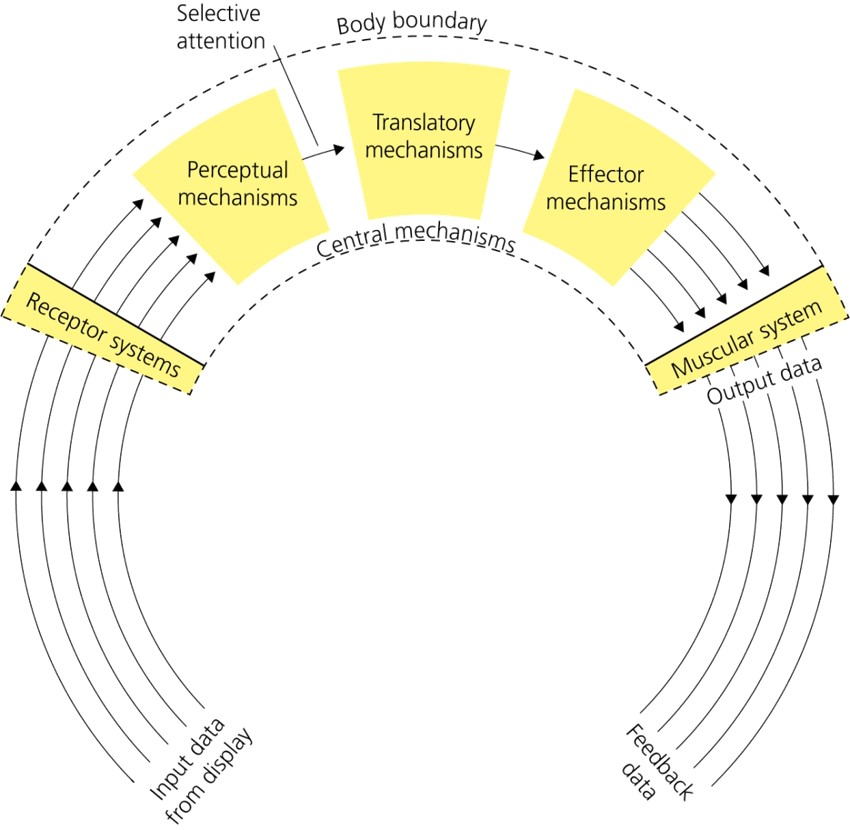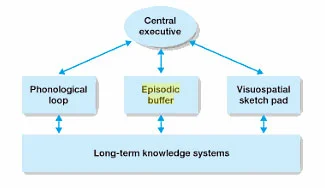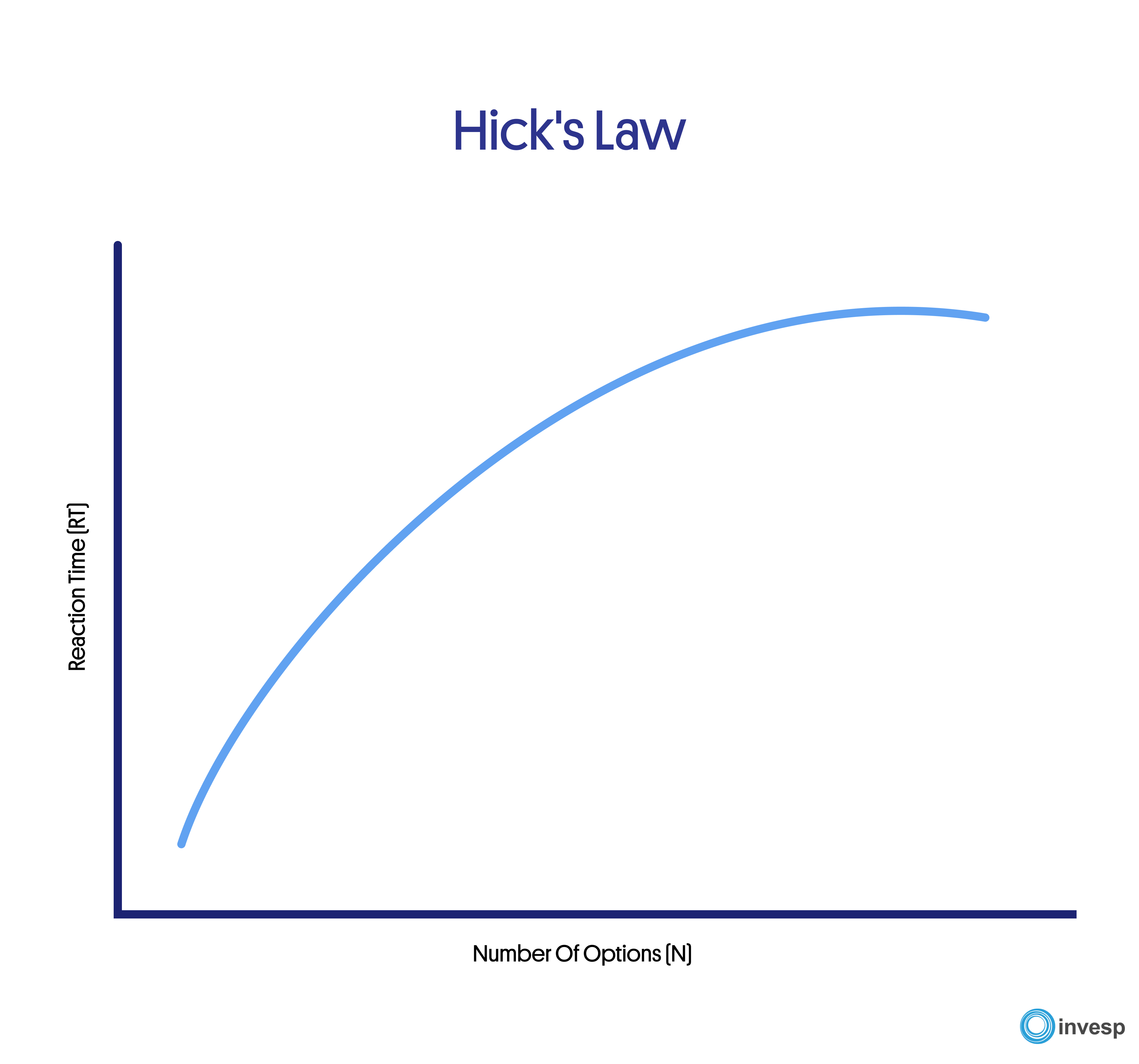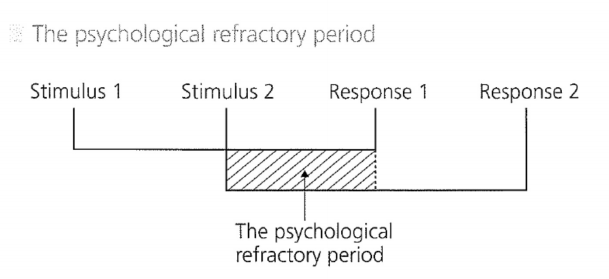9.1 Information processing
1/35
There's no tags or description
Looks like no tags are added yet.
Name | Mastery | Learn | Test | Matching | Spaced |
|---|
No study sessions yet.
36 Terms
Information processing
The methods by which data from the environment are collected and utilised
Input
Information picked up by the senses from the environment
Display
The sporting environment
Senses
Receptor systems pick up the sense and they’re either external or internal
-Sight
-Auditory sense
-Touch
-Balance
-Kinesthesis
Decision making (selective attention)
The second stage of information processing is decision making. At this point, the perfumer must make a decision based on all the information collected by the senses. The performer must separate the relevant and irrelevant information collected to make the right decision, this is called selective attention.
Methods to develop selective attention
-Stimulus can be made more intense, loud or bright when performer is training to help develop concentration. FE- using a brightly coloured ball.
-Train with distractions like in a real life game. FE- train with a loud speaker a loud speaker with crowd noises and a national anthem.
-Improve motivation by using rewards such as positive comments.
-Mental practice. FE- a climber preparing their moves before starting.
Benefits of selective attention
-Improves reaction time
-Concentrate on more detailed aspects of the task.
-Helps the decision making process
Perceptual mechanisms
Detect- pick up important info, selective attention
Comparison-compare to previous knowledge
Recognition- identified correct response to use
Translatory mechanisms
Coverts information & compares it to choose correct programme
Effector mechanism
Nerves that send impulses to the muscle
Whitings model

The working memory - Baddeley and Hitch

Central executive
The control centre of the working memory model, it uses three other ‘systems’ to control all the information moving in and out of the memory system.
Phonological loop
Deals with auditory information from the senses and helps produce the memory trace.
Visuospatial sketchpad
Used to temporarily store visual and spatial information
Episodic buffer
Co-ordinates the sight, hearing and movement information from the working memory into sequences to be sent to the long-term memory.
Working memory
The working memory picks up relevant information from the sporting environment and once this information is received, the memory goes to wok. Selective attention removes irrelevant information. The working memory has links with LTM, sending coded information for future storage and use.
Long-term memory
Once information has been collected, the working memory produces a mental snapshot of the skill being used and compares it with information in the LMT. The LTM can send information back to the working memory for use in the current sporting situation.
Characteristics of the memory system
-Working memory has limited capacity, it can store 7±2 items for approximately 30 seconds
-If a skill is practiced/rehearsed, it can be transferred and stored in the LTM and stored as a motor programme
-The LTM has unlimited capacity and stores information for an unlimited time.
Storing Information
-Mental practice
-Association
-Focus
-Chunking
-Rewards
-Chaining
-Repetition
Schmidts Schema theory
Schema theory suggests that rather than use a structured set of movements to develop skills, the core principles can be taken from one existing motor programme and then adapted, using some information from the environment and using feedback from the sense.
Parameters of a schema
Recall
Initial conditions- Where am I? Information from the display must be recognised
Response specifications- what do I need to do? Information used from the environment is used to assess available options open to the performer.
Recognition
Sensory consequences- how did it look and feel?
Response outcome- did it work?
Developing schema
In order to develop schema you must be places in a number of different situations to form memories from the successes and failures in these situations.
Reaction time
The time taken from the onset of a stimulus to the onset of a response.
Time taken to process the stimuli.
Movement time
The time take to complete the task. Muscular response, how long we are physically moving for.
Response time
The time taken from the inset of the stimulus to the completion of a task.
Reaction time+ movement time.
Simple reaction time
One specific response to one stimulus.
As there is only one choice the reaction is fast, with only one response to perform the athlete is only thinking about 1 thing.
Choice reaction time
Choosing from multiple stimuli creates choice, there are potentially many available responses.
The decision making process and the response time is longer.
factors affecting reaction time
Simple vs choice
Age
Fatigue
Gender
Drugs/ alcohol
Stimulus intensity
Arousal level
Fitness
Experience
Hick’s law
This states that as the number of choices increases, so does the reaction time.

Single-channel hypothesis
States that only 1 stimulus can be processed at once. A second stimuli has to wait before being processed. The delay in processing a second stimulus increases response time.
Psychological refractory period
-Describes the delay that occurs when we get presented with two stimuli close together.
-We can only process one stimulus at a time, although a second stimulus often arrives before the first has been dealt with.
-A second stimulus, presented before the first has been processed, causes a delay.

Improving response time
-Mental Practice - Go over the task to predict a response - works well with predictable, closed, serial skills.
-Practice Specific Response - produce a go to response, like saving penalties always dive one direction.
-Concentration - pick up the stimulus early, focus on one specific cue.
-Fitness - Speed / Power - Interval training and plyometrics increase speed of muscular contractions.
-Anticipation (research / homework to predict) - watch what others have done before and learn to do the same
Anticipation
The attempt to pre-judge a stimulus, working out what is going to happen using information/cues from the environment by either prior research or learning opponent’s typical responses.
Temporal anticipation
When it is going to happen
Spatial anticipation
Where/ what is going to happen